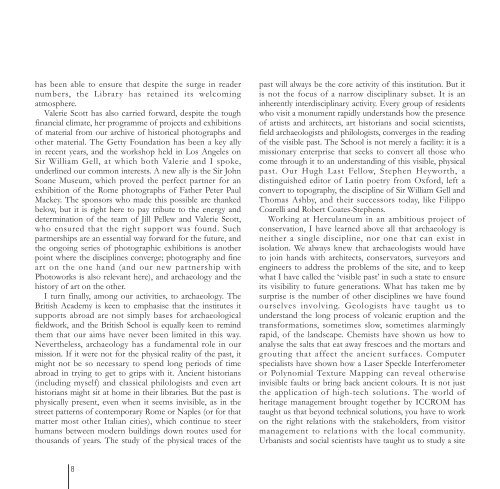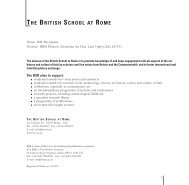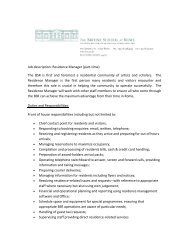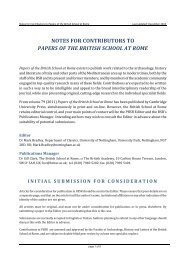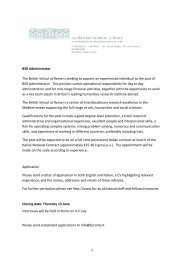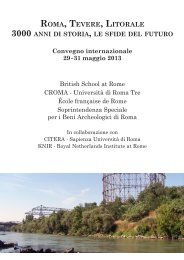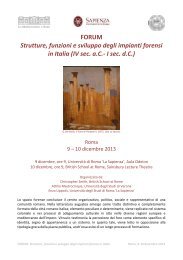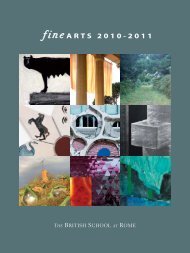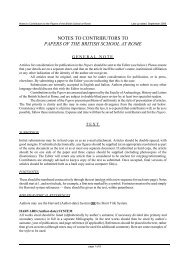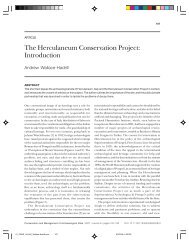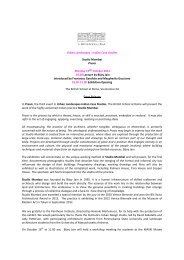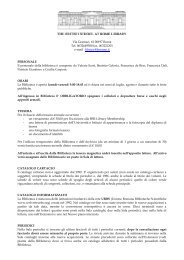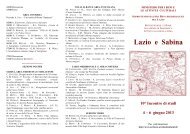Annual Report 2008-9 - The British School at Rome
Annual Report 2008-9 - The British School at Rome
Annual Report 2008-9 - The British School at Rome
Create successful ePaper yourself
Turn your PDF publications into a flip-book with our unique Google optimized e-Paper software.
has been able to ensure th<strong>at</strong> despite the surge in reader<br />
numbers, the Library has retained its welcoming<br />
<strong>at</strong>mosphere.<br />
Valerie Scott has also carried forward, despite the tough<br />
financial clim<strong>at</strong>e, her programme of projects and exhibitions<br />
of m<strong>at</strong>erial from our archive of historical photographs and<br />
other m<strong>at</strong>erial. <strong>The</strong> Getty Found<strong>at</strong>ion has been a key ally<br />
in recent years, and the workshop held in Los Angeles on<br />
Sir William Gell, <strong>at</strong> which both Valerie and I spoke,<br />
underlined our common interests. A new ally is the Sir John<br />
Soane Museum, which proved the perfect partner for an<br />
exhibition of the <strong>Rome</strong> photographs of F<strong>at</strong>her Peter Paul<br />
Mackey. <strong>The</strong> sponsors who made this possible are thanked<br />
below, but it is right here to pay tribute to the energy and<br />
determin<strong>at</strong>ion of the team of Jill Pellew and Valerie Scott,<br />
who ensured th<strong>at</strong> the right support was found. Such<br />
partnerships are an essential way forward for the future, and<br />
the ongoing series of photographic exhibitions is another<br />
point where the disciplines converge; photography and fine<br />
art on the one hand (and our new partnership with<br />
Photoworks is also relevant here), and archaeology and the<br />
history of art on the other.<br />
I turn finally, among our activities, to archaeology. <strong>The</strong><br />
<strong>British</strong> Academy is keen to emphasise th<strong>at</strong> the institutes it<br />
supports abroad are not simply bases for archaeological<br />
fieldwork, and the <strong>British</strong> <strong>School</strong> is equally keen to remind<br />
them th<strong>at</strong> our aims have never been limited in this way.<br />
Nevertheless, archaeology has a fundamental role in our<br />
mission. If it were not for the physical reality of the past, it<br />
might not be so necessary to spend long periods of time<br />
abroad in trying to get to grips with it. Ancient historians<br />
(including myself) and classical philologists and even art<br />
historians might sit <strong>at</strong> home in their libraries. But the past is<br />
physically present, even when it seems invisible, as in the<br />
street p<strong>at</strong>terns of contemporary <strong>Rome</strong> or Naples (or for th<strong>at</strong><br />
m<strong>at</strong>ter most other Italian cities), which continue to steer<br />
humans between modern buildings down routes used for<br />
thousands of years. <strong>The</strong> study of the physical traces of the<br />
8<br />
past will always be the core activity of this institution. But it<br />
is not the focus of a narrow disciplinary subset. It is an<br />
inherently interdisciplinary activity. Every group of residents<br />
who visit a monument rapidly understands how the presence<br />
of artists and architects, art historians and social scientists,<br />
field archaeologists and philologists, converges in the reading<br />
of the visible past. <strong>The</strong> <strong>School</strong> is not merely a facility: it is a<br />
missionary enterprise th<strong>at</strong> seeks to convert all those who<br />
come through it to an understanding of this visible, physical<br />
past. Our Hugh Last Fellow, Stephen Heyworth, a<br />
distinguished editor of L<strong>at</strong>in poetry from Oxford, left a<br />
convert to topography, the discipline of Sir William Gell and<br />
Thomas Ashby, and their successors today, like Filippo<br />
Coarelli and Robert Co<strong>at</strong>es-Stephens.<br />
Working <strong>at</strong> Herculaneum in an ambitious project of<br />
conserv<strong>at</strong>ion, I have learned above all th<strong>at</strong> archaeology is<br />
neither a single discipline, nor one th<strong>at</strong> can exist in<br />
isol<strong>at</strong>ion. We always knew th<strong>at</strong> archaeologists would have<br />
to join hands with architects, conserv<strong>at</strong>ors, surveyors and<br />
engineers to address the problems of the site, and to keep<br />
wh<strong>at</strong> I have called the ‘visible past’ in such a st<strong>at</strong>e to ensure<br />
its visibility to future gener<strong>at</strong>ions. Wh<strong>at</strong> has taken me by<br />
surprise is the number of other disciplines we have found<br />
ourselves involving. Geologists have taught us to<br />
understand the long process of volcanic eruption and the<br />
transform<strong>at</strong>ions, sometimes slow, sometimes alarmingly<br />
rapid, of the landscape. Chemists have shown us how to<br />
analyse the salts th<strong>at</strong> e<strong>at</strong> away frescoes and the mortars and<br />
grouting th<strong>at</strong> affect the ancient surfaces. Computer<br />
specialists have shown how a Laser Speckle Interferometer<br />
or Polynomial Texture Mapping can reveal otherwise<br />
invisible faults or bring back ancient colours. It is not just<br />
the applic<strong>at</strong>ion of high-tech solutions. <strong>The</strong> world of<br />
heritage management brought together by ICCROM has<br />
taught us th<strong>at</strong> beyond technical solutions, you have to work<br />
on the right rel<strong>at</strong>ions with the stakeholders, from visitor<br />
management to rel<strong>at</strong>ions with the local community.<br />
Urbanists and social scientists have taught us to study a site


